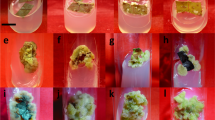Abstract
Endophytic fungi are known to play a vital role in the growth and development of their host plants. We isolated eleven endophytic fungi from the roots of sand-dune plant Elymus mollis and their growth-promoting ability was studied on waito-c rice and Atriplex gemelinii. We found that eight fungal isolates promoted growth of both plants. Fungal isolate EM-7-1 induced maximum growth promotion in waito-c rice (9.25 cm) and Atriplex gemelinii (3.1 cm), which was higher than wild-type Gibberella fujikuroi. Gibberellin analysis of EM-7-1 culture filtrate showed the presence of bioactive gibberellins GA1 (0.32 ng/ml), GA3 (5.76 ng/ml), GA4 (0.82 ng/ml) and GA7: (0.1 ng/ml) along with physiologically inactive GA5 (0.59 ng/ml), GA9 (5.38 ng/ml), GA20 (0.25 ng/ml) and GA24 (2.03 ng/ml). The fungal isolate EM-7-1 was identified as new strain of Gliomastix murorum (G. murorum KACC43902) with 99% sequence homology. This study reports the plant growth-promoting ability of genus Gliomastix and the presence of GA5 in the culture filtrate of fungi for the first time.




Similar content being viewed by others
References
Addy HD, Piercey MM, Currah RS (2005) Microfungal endophytes in roots. Can J Bot 83:1–13. doi:10.1139/b04-171
Bayman B, Lebron LL, Tremblay RL et al (1997) Variation in endophytic fungi from roots and leaves of Lepanthes (Orchidaceae). New Phytol 135:143–149. doi:10.1046/j.1469-8137.1997.00618.x
Choi WY, Rim SO, Lee JH et al (2005) Isolation of gibberellins producing fungi from the root of several Sesamum indicum plants. J Microbiol Biotechnol 15(1):22–28
Hao C, Zhao X, Yang P (2007) GC–MS and HPLC–MS analysis of bioactive pharmaceuticals and personal-care products in environmental matrices. Trends Analyt Chem 26:569–580. doi:10.1016/j.trac.2007.02.011
Hasan HAH (2002) Gibberellin and auxin production plant root fungi and their biosynthesis under salinity–calcium interaction. Rostlinna Vyroba 48(3):101–106
Higgs RE, James AZ, Jeffrey DG et al (2001) Rapid method to estimate the presence of secondary metabolites in microbial extracts. Appl Environ Microbiol 67(1):371–376. doi:10.1128/AEM.67.1.371-376.2001
Kawaide H (2006) Biochemical and molecular analysis of gibberellin biosynthesis in fungi. Biosci Biotechnol Biochem 70(3):583–590. doi:10.1271/bbb.70.583
Kim KS, Lee YS (2000) Rapid and accurate species-specific detection of Phytophthora infestans through analysis of ITS regions in its rDNA. J Microbiol Biotechnol 10:651–655. doi:10.1159/000016110
Kunkel G (1984) Plants for human consumption. Koeltz Scientific Books, ISBN, USA 3874292169
Lee IJ, Foster K, Morgan PW (1998) Photoperiod control of gibberellin levels and flowering in sorghum. Plant Physiol 116:1003–1011. doi:10.1104/pp.116.3.1003
Lee HG, Lee JY, Lee DH (2001) Cloning and characterization of the ribosomal RNA gene from Gonyaulax polyerdra. J Microbiol Biotechnol 11:515–523
MacMillan J (2002) Occurence of gibberellins in vascular plants, fungi and bacteria. J Plant Growth Regul 20:387–442. doi:10.1007/s003440010038
Mineo L (1990) Plant tissue culture techniques; In tested studies in laboratory teachings. Proc ABLE 11:151–174
Modess O (1941) Zur Kenntins der Mykorrhizabildner von Kiefer und Fichte. Symb Bot Ups 5:1–146
Nishijima T, Koshioka M, Yamazaki H et al (1995) Endogenous gibberellins and bolting in cultivars of Japanese Radish. Acta Hortic 394:199–206
Rim SO, Lee JH, Choi WY et al (2005) Fusarium proliferatum KGL0401 as a new gibberellin-producing fungus. J Microbiol Biotechnol 15(4):809–814
Schmelz EA, Engelberth J, Alborn HT et al (2003) Endophytes as sources of bioactive products. Microbes Infect 5:535–544. doi:10.1016/S1286-4579(03)00073-X
Strobel G, Daisy B (2003) Bioprospecting for microbial endophytes and their natural products. Microbiol Mol Biol Rev 67:491–502. doi:10.1128/MMBR.67.4.491-502.2003
Sugita T, Nishikawa A (2003) Fungal identification method based on DNA sequence analysis. Reassessment of the methods of the pharmaceutical society of Japan and the Japanese pharmacopoeia. J Health Sci 49(6):531–533. doi:10.1248/jhs.49.531
Tamura K, Dudley J, Nei M, et al (2007) MEGA4: molecular evolutionary genetics analysis (MEGA) software version 4.0. Mol Biol Evo pp 1596–1599
Vandenbussche F, Fierro AC, Wiedemann G et al (2007) Evolutionary conservation of plant gibberellin signalling pathway components. BMC Plant Biol 7:65. doi:10.1186/1471-2229-7-65
Vandenkoornhuyse P, Baldauf SL, Leyval C et al (2002) Extensive fungal diversity in plant roots. Science 295:2051. doi:10.1126/science.295.5562.2051
Vazquez MM, Cesar S, Azcon R et al (2000) Interaction between arbuscular mycorrhizal fungi and other microbial inoculants (Azospirillum, Pseudomonas, Trichoderma) and their effects on microbial population and enzyme activities in the rhizosphere of maize plants. Appl Soil Ecol 15:261–272. doi:10.1016/S0929-1393(00)00075-5
Yamada A, Ogura T, Degawa Y et al (2001) Isolation of Tricholoma matsutake and T. bakamatsutake cultures from field-collected ectomycorrhizas. Mycoscience 42:43–50. doi:10.1007/BF02463974
Acknowledgment
This research is a part of ‘Eco-technopia 21 project’ supported by the Korean Ministry of Environment.
Author information
Authors and Affiliations
Corresponding author
Electronic supplementary material
Below is the link to the electronic supplementary material.
Rights and permissions
About this article
Cite this article
Afzal Khan, S., Hamayun, M., Kim, HY. et al. Gibberellin production and plant growth promotion by a newly isolated strain of Gliomastix murorum . World J Microbiol Biotechnol 25, 829–833 (2009). https://doi.org/10.1007/s11274-009-9981-x
Received:
Accepted:
Published:
Issue Date:
DOI: https://doi.org/10.1007/s11274-009-9981-x




